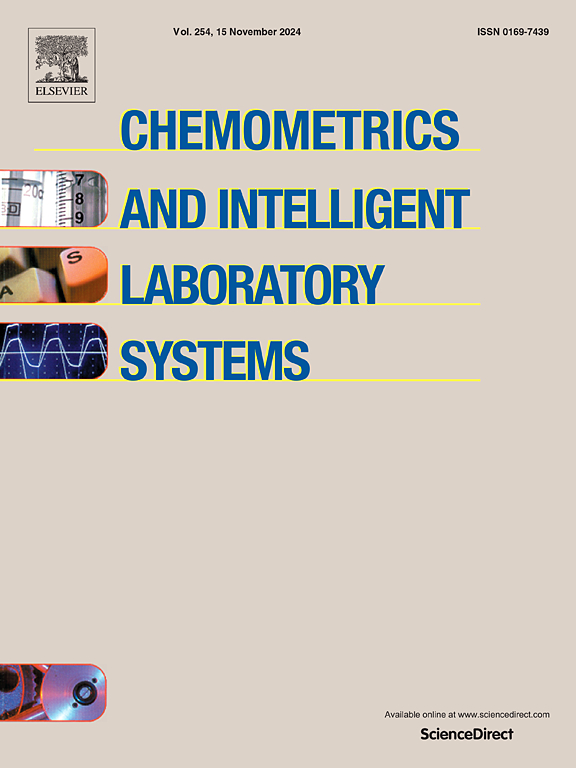Enhanced CO2 leak detection in soil: High-fidelity digital colorimetry with machine learning and ACES AP0
IF 3.7
2区 化学
Q2 AUTOMATION & CONTROL SYSTEMS
Chemometrics and Intelligent Laboratory Systems
Pub Date : 2024-11-02
DOI:10.1016/j.chemolab.2024.105268
引用次数: 0
Abstract
The importance of effective carbon capture and storage (CCS) in addressing climate change issues highlights the need for robust CO2 leak monitoring systems. Limitations of conventional methods have prompted interest in alternative approaches, such as optical CO2 sensors, which offer non-invasive and continuous monitoring. Here, we present a novel methodology for high-fidelity digital colorimetry to enhance CO2 leak detection in soil, integrating machine learning algorithms with the ACES AP0 color space. Optical CO2 sensors, utilizing a cresol red-based detection solution, were calibrated and validated in a controlled environment chamber designed to simulate CO2 leakage. Digital images of the sensor's colorimetric response to varying CO2 levels were analyzed in five color spaces. The ACES AP0 color space, renowned for its expansive color gamut and perceptual uniformity, exhibited optimal performance in discerning subtle color variations induced by changes in CO2 concentration. Ten machine learning regression models were evaluated, and Multivariate Polynomial Regression (MPR) emerged as the most effective in converting ACES AP0 color data into precise CO2 concentration estimates, achieving a Mean Absolute Percentage Error (MAPE) of 2.9 % and a Root Mean Square Error (RMSE) of 0.0731. Field validation at a carbon capture and storage (CCS) facility corroborated the robustness and accuracy of this method, showcasing its potential for real-world applications in CCS and environmental monitoring.
增强型土壤二氧化碳泄漏检测:高保真数字比色法与机器学习和 ACES AP0
有效的碳捕集与封存(CCS)对解决气候变化问题非常重要,这就凸显了对强大的二氧化碳泄漏监测系统的需求。传统方法的局限性激发了人们对替代方法的兴趣,例如二氧化碳光学传感器,它可以提供非侵入式的连续监测。在这里,我们介绍了一种新方法,它将机器学习算法与 ACES AP0 色彩空间相结合,通过高保真数字比色法来提高土壤中二氧化碳泄漏的检测能力。利用甲酚红检测溶液的光学二氧化碳传感器,在模拟二氧化碳泄漏的受控环境室中进行了校准和验证。在五个色彩空间中分析了传感器对不同二氧化碳浓度的比色反应的数字图像。ACES AP0 色彩空间因其广阔的色域和感知均匀性而闻名,在分辨二氧化碳浓度变化引起的细微色彩变化方面表现出最佳性能。对十种机器学习回归模型进行了评估,发现多变量多项式回归模型(MPR)在将 ACES AP0 颜色数据转换为精确的二氧化碳浓度估计值方面最为有效,其平均绝对百分比误差 (MAPE) 为 2.9%,均方根误差 (RMSE) 为 0.0731。碳捕集与封存(CCS)设施的现场验证证实了该方法的稳健性和准确性,展示了其在 CCS 和环境监测领域的实际应用潜力。
本文章由计算机程序翻译,如有差异,请以英文原文为准。
求助全文
约1分钟内获得全文
求助全文
来源期刊
CiteScore
7.50
自引率
7.70%
发文量
169
审稿时长
3.4 months
期刊介绍:
Chemometrics and Intelligent Laboratory Systems publishes original research papers, short communications, reviews, tutorials and Original Software Publications reporting on development of novel statistical, mathematical, or computer techniques in Chemistry and related disciplines.
Chemometrics is the chemical discipline that uses mathematical and statistical methods to design or select optimal procedures and experiments, and to provide maximum chemical information by analysing chemical data.
The journal deals with the following topics:
1) Development of new statistical, mathematical and chemometrical methods for Chemistry and related fields (Environmental Chemistry, Biochemistry, Toxicology, System Biology, -Omics, etc.)
2) Novel applications of chemometrics to all branches of Chemistry and related fields (typical domains of interest are: process data analysis, experimental design, data mining, signal processing, supervised modelling, decision making, robust statistics, mixture analysis, multivariate calibration etc.) Routine applications of established chemometrical techniques will not be considered.
3) Development of new software that provides novel tools or truly advances the use of chemometrical methods.
4) Well characterized data sets to test performance for the new methods and software.
The journal complies with International Committee of Medical Journal Editors'' Uniform requirements for manuscripts.

 求助内容:
求助内容: 应助结果提醒方式:
应助结果提醒方式:


